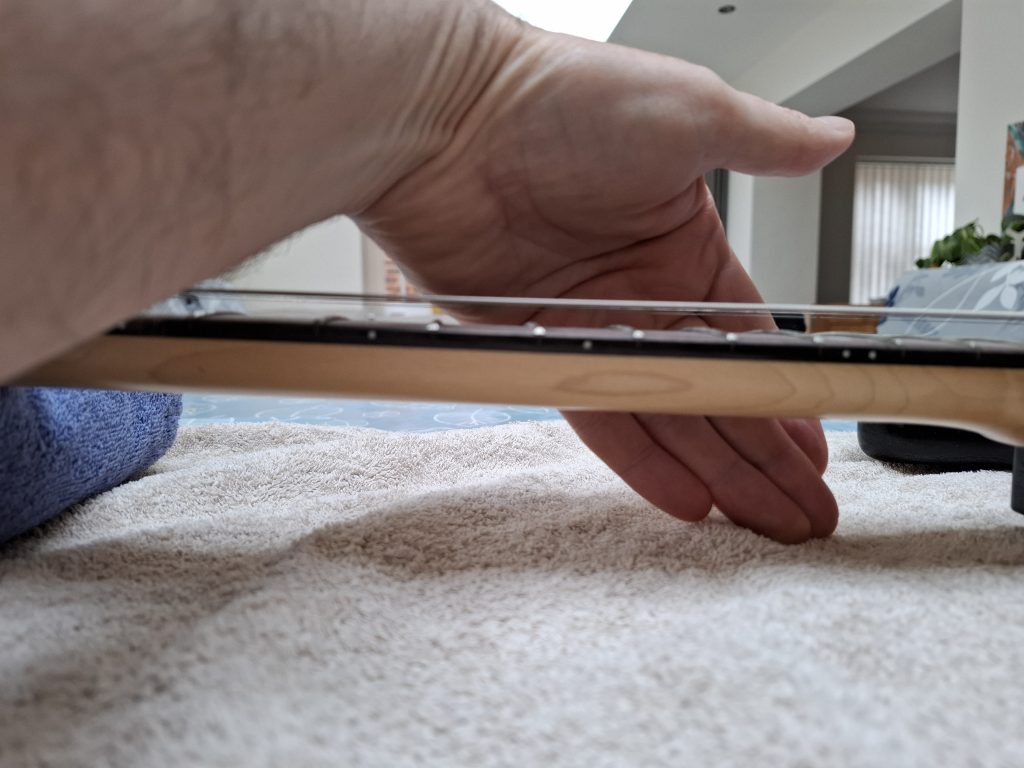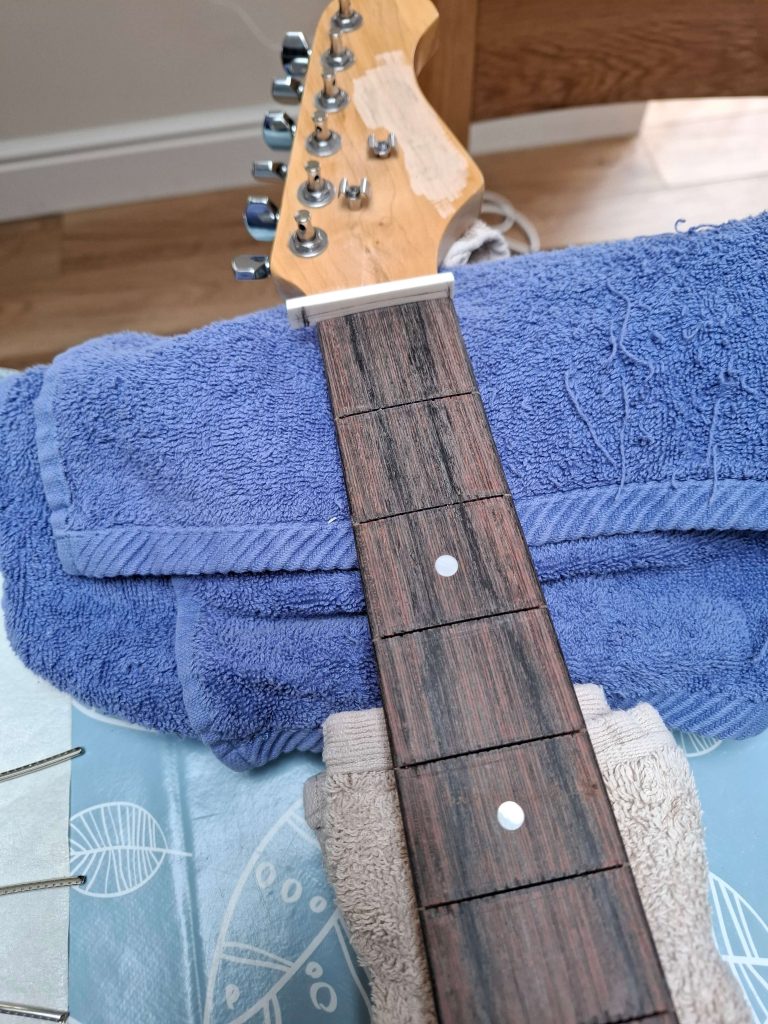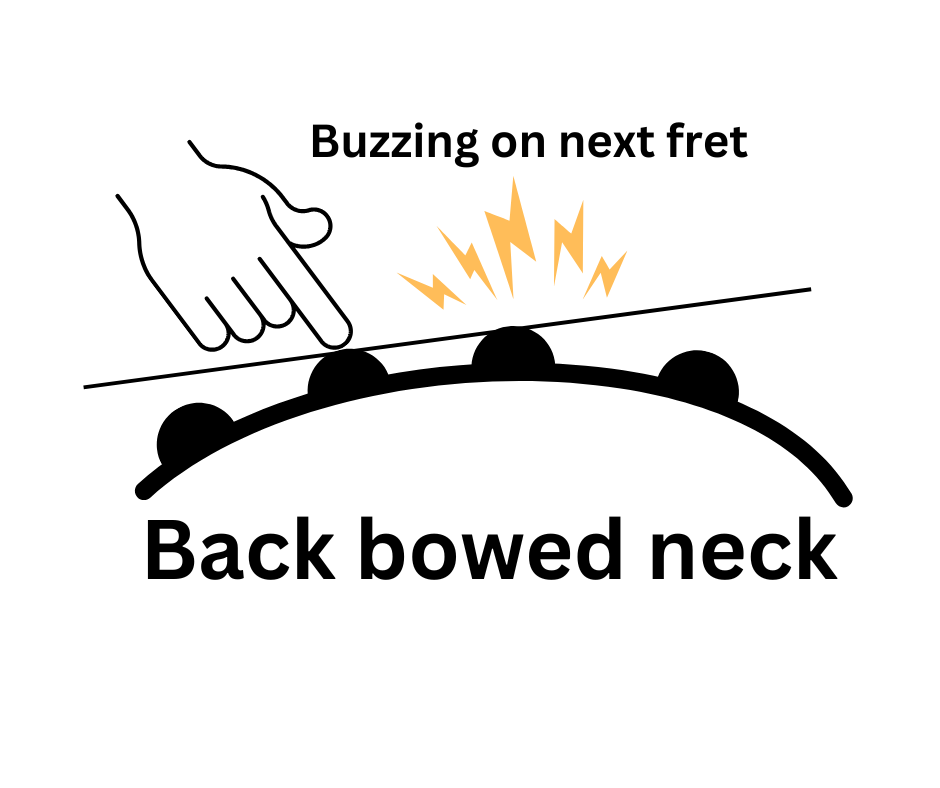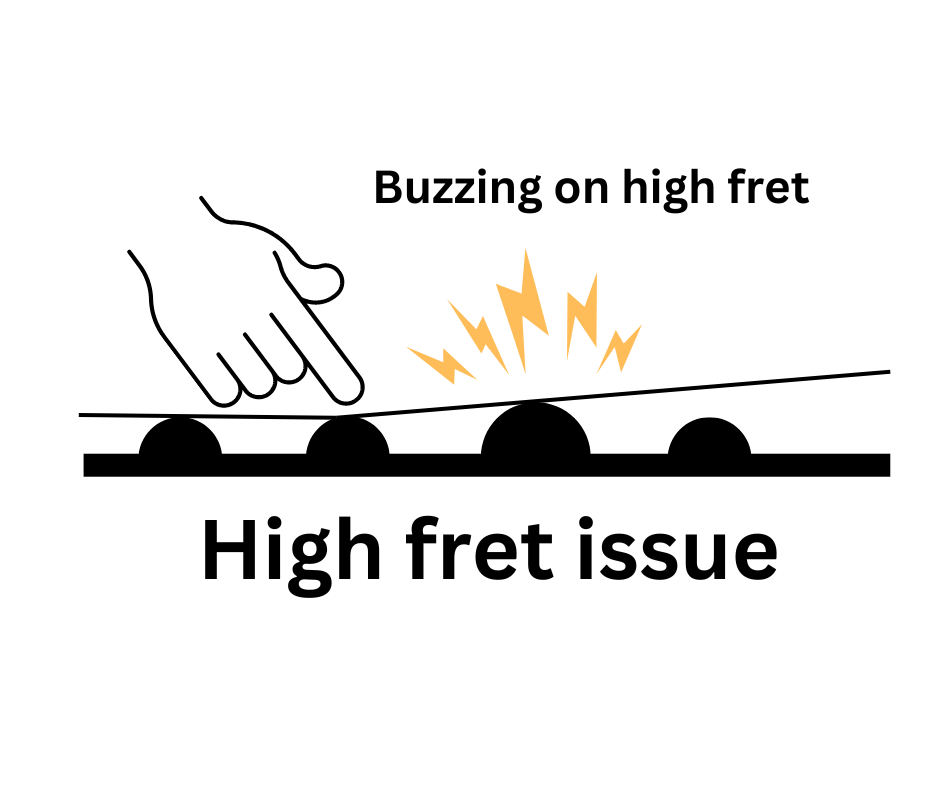Ever picked up your guitar or bass and thought, “Why does this feel so hard to play?” You’re definitely not alone. Having a guitar or bass that isn’t working right makes playing hard work – and can even put you off your practice altogether – even more so if you’re a child. And we all know how hard it can be to get a child to practice their instrument.
Whether you’re new to playing or you’ve been strumming away for years, playability issues can turn your musical enjoyment into frustration fast.
But don’t worry—most of these problems are easier to fix than you might think.
Let’s take a look at the 5 most common issues that could be making your guitar or bass hard to play and – importantly – how you can get things back on track and get back to enjoying your instrument 🙂
Table of Contents
High String Action
One of the most common culprits making guitars difficult to play is high string action (especially on new instruments) —the height of the strings above the fretboard.
If your strings are too high, you’ll find yourself working extra hard just to press them down, quickly leading to sore fingers and sloppy playing and hand fatigue.
Lowering the action can transform your instrument’s feel, making chords and solos easier, cleaner, and way more enjoyable.

So what causes this and how can we fix it?
- Saddles set to high – This is the easiest thing to adjust (on electric guitars and basses). The saddles are what the strings sit on at the bottom of the instrument (on top of the bridge).
Fix: On an electric guitar or bass you can adjust the saddles with a screwdriver or allen key and lower the strings (and therefore action height).
If you have an acoustic guitar it’s a bit trickier as you’ll need to remove the saddle completely and sand down the bottom (therefore reducing the height). Make sure you sand the bottom 100% flat or you’re creating more problems than you’re solving!
When adjusting saddles, it’s really important to make sure that they are respecting the radius of the fretboard, otherwise you’ll have strings that are too low/high relative to the others (you can get radius gauges on Amazon etc). - Nut slots are not cut low enough – the nut is what the strings rest on at the headstock end of a guitar or bass. Each string has it’s own slot. If they are not cut low enough, then playing your ‘cowboy’ chords at the top of the neck will require some serious effort as the strings are too far away from the 1st frets.
Fix: Easier to say but harder to do – the solution is to cut each nut slot to the perfect height. Now you will need some very specific tools for this job – nut slotting files have sizes for each string.
Do NOT be tempted to buy cheap nut slotting files – they are almost always the wrong sizes – and will ruin your nut. Decent nut slotting files are going to be around £80+ a set (yep…) but they will do the job right.
Also be really careful when cutting, if you cut too much you are pretty much throwing away the nut and starting again (you could shim it depending on how it went).
All sounding a bit scary? Kind of is at 1st, but you get the hang of it with practice (and good tools).
Of course if you don’t want to take that on yourself, your local friendly guitar tech or luthier will be happy to help (if you’re in West Sussex and close to the Haywards Heath area, just send me an email). - Neck relief – how curved or straight your guitar or bass neck is, has massive impact on playability – but there’s quite a lot to it – so read more about that below 🙂

Neck Relief Problems
Another sneaky issue affecting playability is neck relief, or how much ‘curve’ your guitar’s neck has.
If there’s too much curve, the guitar becomes harder to play, with strings feeling tougher to press down (raising the action especially in the middle of the instrument). And this can be caused by changes in temperature – including extreme heat (yes summer is not all good for guitars).
If there isn’t enough relief (the neck is too straight – or even back bowed), and you’ll start hearing annoying fret buzz. This is because you are effectively pulling the strings towards the fretboard – making them too low, so when you fret a note, the string is also hitting the next fret down – which causes the buzz.
Strings need room to oscillate properly so that they can ring and sustain without being ‘choked’.
If you think about a guitar or bass string, it is fixed at each end – so when you pluck it, it vibrates and oscillates around.
Now, because it is fixed at both ends, that means it oscillates more in the middle – and because of this, it means that in an ideal situation, there will be more relief (or ‘room’) at the middle of the neck to let this happen freely.

Getting the relief right can dramatically improve your guitar’s playability—trust me, it’s worth checking, this is the cornerstone of a good guitar or bass setup!
Fix: To change the relief of your neck, you adjust the truss rod. This is usually done at the headstock end of the guitar (except for vintage fenders, where you’ll need to remove the neck and adjust with a screwdriver and the bottom of the neck).
When doing this remember the saying ‘righty tighty, lefty loosey’
Tightening the truss rod will remove relief from the neck, making it straighter. Loosening the truss rod will ‘add’ relief to the neck (in reality what is happening is that a looser truss rod allow the tension of the strings to pull the neck into a curve).
How do you know when you have the right amount of neck relief? You can use feeler gauges to measure.
I like to use the following imperial measurements (there is no right or wrong – but these measurements work very well in my experience): 0.006 for electric guitars, 0.008 for basses and acoustics and finally 0.010 for classical acoustic guitars.
- Make sure the instrument is tuned to pitch and held in the playing position (if you lay it flat, gravity will lie to you!).
- Put a capo on the 1st fret, hold down the 12trh fret and then insert a feeler gauge at the 6th fret.
- Adjust the truss rod until the feeler gauge just lightly scrapes the string as you run it along the 6th fret
With enough practice you can do this by feel and sight alone, but feeler gauges really help imo and are very cheaply purchased in car stores etc (Halfords and so on).
Two important things:
- Never force a truss rod – if it doesn’t want to turn anymore, respect it’s wishes! If you break your truss rod you have a BIG problem.
- Make sure you are using the right size allen key/nut driver – if you use the wrong one, you can strip the nut on the truss rod, and that is a huge pain to sort out!
Worn or Uneven Frets
Frets wear out over time—it’s just a fact of guitar and bass life.
When they become uneven, dented, or worn, you’ll notice your notes sounding buzzy or muffled, and chords just won’t ring clearly.
If your guitar feels awkward or sounds off, fret wear could be the reason.
A quick fret-level or replacement can breathe new life into your instrument.
Fret levelling does exactly what it says on the tin – it’s the process of filing down and re-crowning your frets to get them all the same height.
This isn’t an easy DIY job, but if you fancy a go, I’ve written a guide on fret levelling that you can read here.

Dodgy tuners
If your guitar or bass won’t stay in tune, playing becomes a nightmare.
The machine heads on tuners will wear out over time, and on cheaper instruments they don’t come with the best tuners to start with.
This means strings will slip (constantly going out of tune) and can even lead to strings snapping all the time (no-one wants that!).
If your tuners are slipping, stiff, or feel gritty when turning, you’re fighting a losing battle.
Old or budget tuners can’t hold string tension reliably, making staying in tune feel like an impossible dream.
Upgrading to decent quality, properly fitted tuners makes a world of difference—keeping you sounding good and feeling way less stressed!
Fix: Buy some and install some decent tuners! The good news is, these days you can pick up some pretty decent tuners for around the £30 mark – and it’s an easy job to do yourself. All you need is a couple of spanners 🙂
If you are looking for some budget brands that I’ve had good experiences with – try Guyker and Wilkinson. If you want to push the boat out a bit more – Gotoh tuners are exceptional and will last you a loooooong time.
My tip – don’t bother with locking tuners, they do nothing to help tuning stability (fight me in the comments…) but you WILL pay more for the ‘privilege’ of buying them….
Old or Unsuitable Strings
Strings don’t last forever, and old or unsuitable strings can drastically affect playability.
Old strings lose their clarity, become harder to tune, and feel unpleasant under your fingers – and sound dull and lifeless.
Choosing the right gauge and regularly replacing your strings can breathe new life into your guitar or bass 🙂
Fix: Get some new strings! If you want a recommendation from me, I personally love and only use D’addario XL range (for guitars and basses). They tune up fast, hardly every break AND hold tune incredibly well (and I love the slick feel of them).
Conclusion:
Most guitar playability issues aren’t permanent—they’re easily solved with some simple adjustments.
Whether it’s lowering the string action, correcting neck relief, fixing fret issues, or replacing tuners and old strings, you have plenty of options to get your guitar playing at its best again.
If you’re not sure how to tackle these adjustments yourself, I’m always here to help.
At Stu’s Guitar Setups, I specialise in solving these common guitar playability problems quickly and professionally.
Feel free to get in touch for friendly advice or to book your guitar or bass in—I’d love to help you fall back in love with your instrument!
Bio: Who is Stu?
I’m a ‘one man band’ doing guitar tech and guitar setup work.

I pride myself on improving the playability of guitars (electric and acoustic) as well as basses. I’m a huge geek for guitars and genuinely love setting them up 🙂
I’ve been doing setups for myself and friends for years (I started playing in bands over 30 years ago – gulp!) and due to popular demand (friends of friends etc) I started Stu’s Guitar Setups Haywards Heath to offer my services to a wider audience.
I get a lot of positive feedback from customers – please check my google reviews, I think you’ll like what you see 🙂
